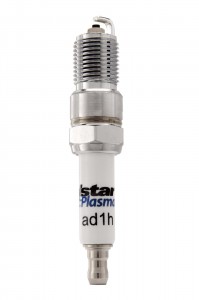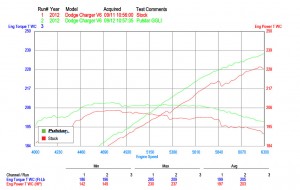 In junior high science class, you probably learned about the three states of matter: solids, liquids, and gases. Chances are you didn’t spend as much time talking about the lesser-known fourth state called plasma.
In junior high science class, you probably learned about the three states of matter: solids, liquids, and gases. Chances are you didn’t spend as much time talking about the lesser-known fourth state called plasma.
Plasma, which is created by subjecting gas to a large amount of electrical energy, isn’t a new concept. However, plasma-assisted combustion is a relatively new idea and its revolutionizing the way spark plugs are designed. By harnessing the power of plasma, companies like Pulstar are able to create spark plugs that deliver substantial, dyno-proven horsepower and torque gains.
The Power of Plasma
To form plasma, gas atoms are subjected to a large amount of energy and broken apart to form a collection of positively and negatively charged highly reactive particles. Plasma consists of positively charged ions with most or all of their detached electrons moving freely about in a very active manner; these electrons react with other atoms.

On the left, you see gas atoms with a positive core and orbiting negative electrons. The image on the right show what happens when these atoms are exposed to a large amount of energy. They are broken apart into a collection of positively and negatively charged particles, which is highly volatile. This is plasma.
“Scientists know that by introducing plasma to the reaction — near or at the location where the flame ignites — new chemical species are produced that catalyze combustion,” according to the American Physical Society, the world’s largest organization of physicists.
Because plasma is extremely reactive, it ignites immediately and combusts rapidly. In addition, large amounts of the remaining gaseous fuel can also be ignited instantly by the large ball of burning plasma-affected fuel.
The key is producing the energy needed to convert the gas to plasma, and Pulstar has figured out a way to do it.
How it Works
Pulstar Spark Plugs use an integrated capacitor they developed with the help of Sandia National Laboratories (a U.S. Department of Energy research and development laboratory) to store, accumulate, and compress energy. When the spark is formed, energy stored in the capacitor is released in a quick and powerful pulse equal to 5 million watts (see the animation below). It takes approximately three nanoseconds to complete the pulse, and it’s intense enough to convert the gaseous air/fuel mixture into a highly excited plasma.
The high-intensity pulse offers three major benefits:
Instant Ignition
The pulse creates a flash of heat that helps the fuel charge reach the required light-off temperature to ignite the air-fuel mixture. The heat provided by the plasma gives the air-fuel mixture a head start to achieving the temperature required to ignite. In addition, this pulse ionizes the gaseous air/fuel mixture, breaking down air/components like H² and O² into their atomic state H and O where they are most volatile. These highly excited elements react to the spark by igniting instantly. The result is improved throttle response.
Quicker Burn
The high-intensity pulse breaks apart the long hydrocarbon chains found in the nearby air-fuel mixture into shorter chains that react quickly. This rapid burn creates higher peak pressure on the piston and applies more torque on the crank, resulting in more power to your wheels.
The video below shows the rapid, complete burn created by plasma from Pulstar’s spark plugs.
Complete Burn
The portion of the fuel that contains shortened hydrocarbon chains burns faster, and creates a larger surface area to ignite the rest of the gaseous air-fuel mixture. This allows the air-fuel mixture to burn more completely during the power stroke, ensuring you get the most power from your fuel.
There is one final advantage to plasma-assisted combustion.
Pulstar Spark Plugs are able to use a larger-diameter electrode for longer life without compromising performance. In contrast, many modern spark plugs use a fine center-wire plug, which allow ions to form in a compressed area for more consistent spark formation. The downside to this design is that some materials burn too quickly, shortening the lifespan of the plug. This has caused spark plug manufacturers to use precious metals such as iridium and platinum for their center electrode material.
Because of the pulse-assisted nature of Pulstar plugs, they are able to utilize a larger electrode. The stored energy from the capacitor creates a 5 million-watt pulse that produces a spark channel 10 times larger than conventional plugs. While typical spark plugs will ignite fuel at variable times between 0 and 500 microseconds after the spark is present, Pulstar plugs ignite the fuel mixture instantaneously at spark creation and burn it completely each time.
If all this scientific talk makes your eyelids heavy, there are a few dyno numbers that might open your eyes. For example, a 2014 Mustang V6 added 9 extra ft.-lbs. of torque by switching to Pulstar spark plugs. A 2012 Dodge Charger V6 gained 7 horsepower with a simple plug swap. The plugs have also been used by F1 and LeMans teams.
“We have used plasma-assist with great success on many F1 cars to improve vehicle performance,” said Danilo Gardi, who has over 30 years’ experience with a major European ignition system manufacturer and calibrating F1 and Le Mans Series prototype race cars. “(Pulstar) has elegantly and inexpensively delivered this technology in their Pulstar spark plugs; truly incredible.”
Spark formation and ignition timing are key to optimum engine performance, and plasma-assisted combustion from Pulstar spark plugs might just be the secret to bringing it all together.




Interesting read, so where are these plugs available at and at what price?
http://www.summitracing.com/int/parts/epl-ef1h10/overview/
Are these Pulstar sparkplugs available in a short header style plug?
As of now, Pulstar says it is unable make short plugs and get enough capacitance in the plug to make plasma.
How would these work on methanol or nitro?
Pulstar employee here. First, a big thank you to David Fuller. This is the best explanation of our tech I’ve seen yet!
To answer your question, the harder to ignite the fuel the more we shine (no pun intended). We are used in some DoD applications for this exact reason: https://pulstar.com/wp-content/uploads/2015/08/Raider-Testimonial.pdf
Any adjustment to timing or plug gap?
No adjustment, just install and ready.
I have a 2013 Audi S5 with the supercharged twin turbo v-6 , what kind of increased HP and torque should I expect with these plugs and do they have any negetive side effects on the wearing out of this engine ?
Chris
Any adjustment to timing or plug gap?
Mini cooper s n14 r56 2010